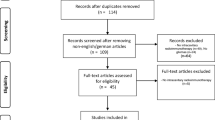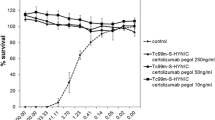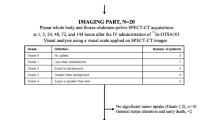Abstract
Purpose
The extra-domain A1 of tenascin-C (TC-A1) is highly expressed in the extracellular matrix of tumours and on newly formed blood vessels and is thus a valuable target for radionuclide therapy. Tenarad is a fully human miniantibody or small immunoprotein (SIP, molecular weight 80 kDa) labelled with 131I that is derived from a TC-A1-binding antibody. Previous phase I/II studies with a similar compound (131I-L19SIP) used for radioimmunotherapy (RIT) have shown preliminary efficacy in a variety of cancer types. In this ongoing phase I/II trial, Tenarad was administered to patients with recurrent Hodgkin's lymphoma (HL) refractory to conventional treatments.
Methods
Eight patients (four men, four women; age range 19 – 41) were enrolled between April 2010 and March 2011. All patients had received a median of three previous lines of chemotherapy (range three to six) and seven had also undergone autologous stem cell transplantation (ASCT) or bone marrow transplantation. In addition, seven patients received external beam radiation. All patients had nodal disease, constitutional B symptoms and some showed extranodal disease in skeletal bone (four patients), lung (three), liver (two) and spleen (one). Baseline assessments included whole-body FDG PET with contrast-enhanced CT and diagnostic Tenarad planar and SPECT studies. Patients were considered eligible to receive a therapeutic dose of Tenarad (2.05 GBq/m2) if tumour uptake was more than four times higher than that of muscle.
Results
All patients were eligible and received the therapeutic dose of Tenarad. Only one patient developed grade 4 thrombocytopenia and leucocytopenia, requiring hospitalization and therapeutic intervention. All other patients had haematological toxicity of grade 3 or lower, which resolved spontaneously. At the first response assessment (4 – 6 weeks after therapy), one patient showed a complete response, one showed a partial response (PR) and five had disease stabilization (SD). Five patients were given up to three repeated Tenarad treatments. One patient showed SD which then improved to a PR, three showed clinical benefit while maintaining SD and one patient showed disease progression.
Conclusion
Tenarad RIT is effective in chemorefractory HL and resulted in objective responses or clinical benefit in the majority of patients. Toxicity was acceptable despite the high load of prior treatments, previous ASCT and multiple Tenarad administrations. Further studies are planned to define the most effective schedule for this type of RIT in HL patients.



Similar content being viewed by others
References
Bauer K, Skoetz N, Monsef I, Engert A, Brillant C. Comparison of chemotherapy including escalated BEACOPP versus chemotherapy including ABVD for patients with early unfavourable or advanced stage Hodgkin lymphoma. Cochrane Database Syst Rev. 2011:(8):CD007941. doi:10.1002/14651858.CD007941.pub2
Kuruvilla J, Keating A, Crump M. How I treat relapsed and refractory Hodgkin lymphoma. Blood. 2011;117:4208–17.
Uhm J, Kuruvilla J. Treatment of newly diagnosed advanced stage Hodgkin lymphoma. Blood Rev. 2012;26:167–74.
Brice P. Managing relapsed and refractory Hodgkin lymphoma. Br J Haematol. 2008;141:3–13.
Horning S, Fanale M, deVos S, Borchmann P, Illidge T, Engert A, et al. Defining a population of Hodgkin lymphoma patients for novel therapeutics: an international effort [abstract 118]. Ann Oncol. 2008;19 Suppl 4:120–1
Younes A. Novel treatment strategies for patients with relapsed classical Hodgkin lymphoma. Hematology Am Soc Hematol Educ Program. 2009:507–19. doi:10.1182/asheducation-2009.1.507
Illidge T, Morschhauser F. Radioimmunotherapy in follicular lymphoma. Best Pract Res Clin Haematol. 2011;24:279–93.
Kaminski MS, Tuck M, Estes J, Kolstad A, Ross CW, Zasadny K, et al. 131I-tositumomab therapy as initial treatment for follicular lymphoma. N Engl J Med. 2005;352:441–9.
Scholz CW, Pinto A, Linkesch W, Linden O, Viardot A, Keller U, et al. (90)Yttrium-ibritumomab-tiuxetan as first-line treatment for follicular lymphoma: 30 months of follow-up data from an international multicenter phase II clinical trial. J Clin Oncol. 2013;31:308–13.
Silacci M, Brack S, Schirru G, Marlind J, Ettorre A, Merlo A, et al. Design, construction, and characterization of a large synthetic human antibody phage display library. Proteomics. 2005;5:2340–50.
Brack SS, Silacci M, Birchler M, Neri D. Tumor-targeting properties of novel antibodies specific to the large isoform of tenascin-C. Clin Cancer Res. 2006;12:3200–8.
Borsi L, Carnemolla B, Nicolo G, Spina B, Tanara G, Zardi L. Expression of different tenascin isoforms in normal, hyperplastic and neoplastic human breast tissues. Int J Cancer. 1992;52:688–92.
Berndorff D, Borkowski S, Sieger S, Rother A, Friebe M, Viti F, et al. Radioimmunotherapy of solid tumors by targeting extra domain B fibronectin: identification of the best-suited radioimmunoconjugate. Clin Cancer Res. 2005;11:7053s–63s.
Pini A, Viti F, Santucci A, Carnemolla B, Zardi L, Neri P, et al. Design and use of a phage display library. Human antibodies with subnanomolar affinity against a marker of angiogenesis eluted from a two-dimensional gel. J Biol Chem. 1998;273:21769–76.
Tijink BM, Neri D, Leemans CR, Budde M, Dinkelborg LM, Stigter-van Walsum M, et al. Radioimmunotherapy of head and neck cancer xenografts using 131I-labeled antibody L19-SIP for selective targeting of tumor vasculature. J Nucl Med. 2006;47:1127–35.
Erba PA, Sollini M, Orciuolo E, Traino C, Petrini M, Paganelli G, et al. Radioimmunotherapy with radretumab in patients with relapsed hematologic malignancies. J Nucl Med. 2012;53:922–7.
Sauer S, Erba PA, Petrini M, Menrad A, Giovannoni L, Grana C, et al. Expression of the oncofetal ED-B-containing fibronectin isoform in hematologic tumors enables ED-B-targeted 131I-L19SIP radioimmunotherapy in Hodgkin lymphoma patients. Blood. 2009;113:2265–74.
Heuveling DA, de Bree R, Vugts DJ, Huisman MC, Giovannoni L, Hoekstra OS, et al. Phase 0 microdosing PET study using the human mini antibody F16SIP in head and neck cancer patients. J Nucl Med. 2013;54:397–401.
Aldinucci D, Gloghini A, Pinto A, De Filippi R, Carbone A. The classical Hodgkin’s lymphoma microenvironment and its role in promoting tumour growth and immune escape. J Pathol. 2010;221:248–63.
Steidl C, Connors JM, Gascoyne RD. Molecular pathogenesis of Hodgkin’s lymphoma: increasing evidence of the importance of the microenvironment. J Clin Oncol. 2011;29:1812–26.
Oki Y, Younes A. Does rituximab have a place in treating classic Hodgkin lymphoma? Curr Hematol Malig Rep. 2010;5:135–9.
Soini Y, Alavaikko M, Lehto VP, Virtanen I. Tenascin in reactive lymph nodes and in malignant lymphomas. Pathol Res Pract. 1992;188:1078–82.
Younes A, Oki Y, McLaughlin P, Copeland AR, Goy A, Pro B, et al. Phase 2 study of rituximab plus ABVD in patients with newly diagnosed classical Hodgkin lymphoma. Blood. 2012;119:4123–8.
Younes A, Romaguera J, Hagemeister F, McLaughlin P, Rodriguez MA, Fiumara P, et al. A pilot study of rituximab in patients with recurrent, classic Hodgkin disease. Cancer. 2003;98:310–4.
Khnykin D, Troen G, Berner JM, Delabie J. The expression of fibroblast growth factors and their receptors in Hodgkin’s lymphoma. J Pathol. 2006;208:431–8.
Wallentine JC, Kim KK, Seiler 3rd CE, Vaughn CP, Crockett DK, Tripp SR, et al. Comprehensive identification of proteins in Hodgkin lymphoma-derived Reed-Sternberg cells by LC-MS/MS. Lab Invest. 2007;87:1113–24.
Aloj L, D’Ambrosio L, Aurilio M, Marreno R, Menssen HD, Giovannoni L, et al. Preliminary evaluation of radioimmunotherapy with Tenarad, a I-131 labeled antibody fragment targeting the extra-domain A1 of tenascin-C, in patients with refractory Hodgkin lymphoma. Journal of Clinical Oncology, 2011 ASCO Annual Meeting Abstracts. Vol 29, No. 15 suppl, 8063; 2011.
Siegel JA, Thomas SR, Stubbs JB, Stabin MG, Hays MT, Koral KF, et al. MIRD pamphlet no. 16: Techniques for quantitative radiopharmaceutical biodistribution data acquisition and analysis for use in human radiation dose estimates. J Nucl Med. 1999;40:37S–61S.
Buijs WC, Siegel JA, Boerman OC, Corstens FH. Absolute organ activity estimated by five different methods of background correction. J Nucl Med. 1998;39:2167–72.
Stabin MG, Sparks RB, Crowe E. OLINDA/EXM: the second-generation personal computer software for internal dose assessment in nuclear medicine. J Nucl Med. 2005;46:1023–7.
Sgouros G. Bone marrow dosimetry for radioimmunotherapy: theoretical considerations. J Nucl Med. 1993;34:689–94.
Traino AC, Ferrari M, Cremonesi M, Stabin MG. Influence of total-body mass on the scaling of S-factors for patient-specific, blood-based red-marrow dosimetry. Phys Med Biol. 2007;52:5231–48.
Cheson BD, Pfistner B, Juweid ME, Gascoyne RD, Specht L, Horning SJ, et al. Revised response criteria for malignant lymphoma. J Clin Oncol. 2007;25:579–86.
Folkman J. The role of angiogenesis in tumor growth. Semin Cancer Biol. 1992;3:65–71.
Birgersdotter A, Baumforth KR, Porwit A, Sjoberg J, Wei W, Bjorkholm M, et al. Inflammation and tissue repair markers distinguish the nodular sclerosis and mixed cellularity subtypes of classical Hodgkin’s lymphoma. Br J Cancer. 2009;101:1393–401.
Birgersdotter A, Baumforth KR, Wei W, Murray PG, Sjoberg J, Bjorkholm M, et al. Connective tissue growth factor is expressed in malignant cells of Hodgkin lymphoma but not in other mature B-cell lymphomas. Am J Clin Pathol. 2010;133:271–80.
Buglio D, Georgakis G, Younes A. Novel small-molecule therapy of Hodgkin lymphoma. Expert Rev Anticancer Ther. 2007;7:735–40.
Jona A, Younes A. Novel treatment strategies for patients with relapsed classical Hodgkin lymphoma. Blood Rev. 2010;24:233–8.
Kwekkeboom DJ, de Herder WW, Kam BL, van Eijck CH, van Essen M, Kooij PP, et al. Treatment with the radiolabeled somatostatin analog [177 Lu-DOTA 0, Tyr3]octreotate: toxicity, efficacy, and survival. J Clin Oncol. 2008;26:2124–30.
Acknowledgments
Philogen SpA sponsored this work under a protocol approved by the internal review board of our institution.
Conflicts of interest
None of the authors from the Istituto Nazionale Tumori, Fondazione “G. Pascale”, Napoli, Italy, received compensation for this study and none declare conflicts of interest. The remaining authors (D.N., L.G. and H.D.M.) are shareholders or employees of the protocol sponsor, Philogen SpA.
Author information
Authors and Affiliations
Corresponding author
Rights and permissions
About this article
Cite this article
Aloj, L., D’Ambrosio, L., Aurilio, M. et al. Radioimmunotherapy with Tenarad, a 131I-labelled antibody fragment targeting the extra-domain A1 of tenascin-C, in patients with refractory Hodgkin's lymphoma. Eur J Nucl Med Mol Imaging 41, 867–877 (2014). https://doi.org/10.1007/s00259-013-2658-6
Received:
Accepted:
Published:
Issue Date:
DOI: https://doi.org/10.1007/s00259-013-2658-6




